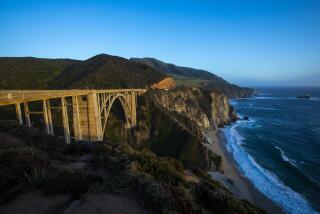State Tries Again to Lease Land for Off-Road Recreation on Otay Mesa
- Share via
SACRAMENTO — While it proposes reopening portions of the Anza-Borrego State Park to off-roaders, the Department of Parks and Recreation is also trying to resurrect a deal with Otay Mesa developer Roque de la Fuente II to lease almost 1,000 acres of his border land for a new off-road vehicle park.
De la Fuente said last week that state administrators had contacted him to renegotiate the deal and a meeting has been scheduled for January.
“They want to sit down and see if we could put the whole deal back together again,” said De la Fuente, who added that he will be asking more money this time around.
Under pressure from the off-roaders--a very vocal, political powerful group--the state has been trying for several years to work out an arrangement with De la Fuente to either buy or lease 978 acres of his family’s land near the Richard J. Donovan state prison and east of the international border crossing at Otay Mesa.
The De la Fuente parcel is the key to assembling a 1,200-acre park where enthusiasts of dirt bikes, all-terrain vehicles and dune buggies would be free to roar over trails and the landscape.
Off-roaders are pushing for the Otay park because it is much closer than the state-owned riding area at Ocotillo Wells. Though the desert romping grounds is the largest in the state--42,000 acres when a phased expansion is completed--it is still three hours from San Diego over the mountains.
The state’s attempt to make the Otay Mesa park a reality hit an early ditch, however, when De la Fuente balked at renting his land because, as legal owner, he could be named on lawsuits if any of the off-roaders were injured in an accident while riding in the park.
Those concerns prompted the state to craft a special deal: It would pay De la Fuente $5.3 million up front and take official ownership of his land for 20 years. The money would not come from public tax money but from the multimillion-dollar “green-sticker” fund stocked by fees charged to off-road-vehicle enthusiasts.
During the 20 years, De la Fuente would be legally faultless for any of the inevitable accidents that would occur on his land. After the two decades, however, he would be able to buy the property back for a mere dollar.
The buy-back provision raised eyebrows around the Capitol when it came time for legislators to bless the deal this year. Some staff analysts resisted the arrangement, especially since the land De la Fuente would be buying back for 100 pennies would be worth at least $100 million in 2010.
There also were questions about the appraised value of De la Fuente’s property. An August, 1987, internal memorandum from the Department of General Services said the property should fetch only about $77 an acre a year, but the Parks Department was offering to pay about $288 an acre--nearly a 275% increase.
Despite a last-minute push by off-roader interests, legislators balked at approving the deal during the waning minutes of the 1989 session, and De la Fuente warned that the state would have to cough up more money to pique his interest.
Since then, a private company interested in using the Otay Mesa real estate as a private landfill has offered to pay De la Fuente more than $400 million over the next 30 years, the developer said last week.
In addition, the County and City of San Diego are interested in using the land for a public landfill and sludge pond, respectively. And the state’s corrections department is also eyeing the property for use as a landfill in conjunction with a proposed trash-to-energy project to be run out of the Donovan prison, De la Fuente said.
Meanwhile, the state’s Department of General Services is finishing up a new appraisal of the property, hoping to clear up all the questions on what the park department should pay for the off-roader park. And now parks officials are ready to sit down for a second chance at opening the Otay Trails to the legions of San Diegans who like to race in the outdoors.
De la Fuente is ready.
“Money always talks,” he said.
More to Read
Sign up for Essential California
The most important California stories and recommendations in your inbox every morning.
You may occasionally receive promotional content from the Los Angeles Times.













